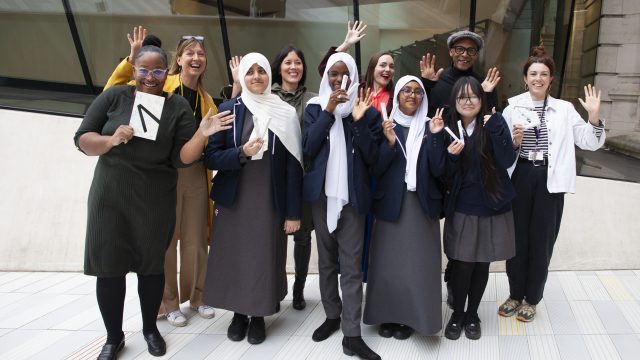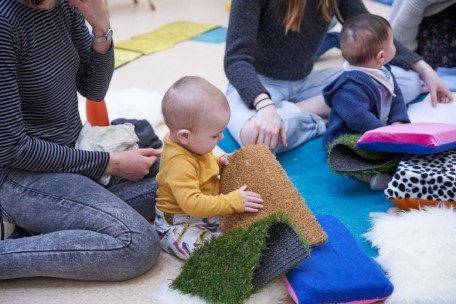
Pisanello, Leonello d’Este Medal, Verona, Italy, Cast Bronze, Medieval and Renaissance Galleries, Room 64, Case 14, Mus Ref: A.165-1910 © Victoria and Albert Museum, London
Portrait medals are fascinating objects for anyone interested in this period, as they embody so many of the characteristics typically associated with the renaissance. Their form and inspiration are derived from classical coins bearing the profiles of emperors, a reminder of the renaissance revival of interest in Antiquity. They were typically made of bronze, a costly material associated with Antiquity that was increasingly prized in this period. Additionally they are examples of an art form that burgeoned in the renaissance: portraiture. Being double-sided, their reverses could be decorated with imagery that enhanced or explained the portrait on the obverse – for instance proclaiming status, commemorating an important event, or allegorising the personality. As a reproductive art form – cast from a mould, with the possibility of being made in multiples – they reflect increasing demand for art objects in the period. Being small and therefore easily transportable, they made ideal gifts, particularly in court circles where a ruler’s portrait was a means of circulating his or her self-image. At the same time they were not simply propaganda tools, but beautiful objects that were intended to be handled, and to prompt discussion and interpretation in cultivated humanist circles. They were, indeed, collectors’ items – like the classical coins that inspired them – reflecting yet another development in this period, when collecting became established as an indicator of wealth and education, not only amongst princes but the affluent middle classes.
The inventor of the portrait medal, and arguably the greatest exponent of the form, was the distinguished north Italian painter Pisanello (c. 1395-1455). It is thought that his first medal, of the Byzantine Emperor John Paleologus, was made at Ferrara in 1438, under the aegis of the cultivated Leonello d’Este (Marquis of Ferrara, 1441-1450). Leonello himself was the most enthusiastic of Pisanello’s many clients, commissioning no less than six different portrait medals from him. This is the largest (just over 10 cm in diameter) and most beautiful of them, made to commemorate Leonello’s marriage to Maria of Aragon, the daughter of Alfonso, King of Aragon and Naples, in 1444.

Pisanello, Leonello d’Este Medal, Verona, Italy, Cast Bronze, Medieval and Renaissance Galleries, Room 64, Case 14, Mus Ref: A.165-1910 © Victoria and Albert Museum, London
The obverse shows Leonello in profile, his stylised mane of hair suggesting a pun on his name (literally ‘little lion’). Above, below and to either side of him, are inscribed his name and titles, including in abbreviated form, his new status as son-in-law of the King of Aragon: GE[nerus] R[egis] Ar[agonum]. It’s worth noting the care with which Pisanello has placed the lettering, making an interesting design out of something potentially unremarkable.
The reverse is one of Pisanello’s most enchanting designs. It shows a lion, king of beasts – again a pun on Leonello’s name – being taught to sing by cupid, a clear allusion to the taming power of love. Behind, the eagle on a bare branch is less easily interpreted, although a similar motif appears in other Este commissions and it may be a family emblem. The motif of the billowing sail on the pillar behind cupid is certainly an Este emblem – it appears on the reverse of another of Leonello’s medals by Pisanello – and references the motto festina lente (proceed cautiously), together with Fortitude, symbolised by the pillar. Pisanello has signed and dated his work, designating himself as Pictoris (painter), as he does on all his medals. Pisanello thought of himself first and foremost as a painter, and indeed this scene, although a miracle of small-scale relief sculpture, is at the same time a thoroughly pictorial conception, with its refined naturalism and elegant design.
Pisanello was greatly in demand as a medallist at all the courts of Italy, from Milan, Ferrara and Mantua to Naples, and died in Rome, where he may have planned to make a medal of the pope. Nearly thirty portrait medals by him, of various rulers and luminaries, survive. You can see some of them, alongside the medal of Leonello, in Gallery 64, case 14.
“Twenty Objects for Twenty Years” are a series of articles written by Paula Nuttall, Director of the Late Medieval to Early Renaissance Year Course. You can find the rest of the series along with other posts from the Learning Department at the V&A on their blog.


